Aditya Mohan
ARLBench: Flexible and Efficient Benchmarking for Hyperparameter Optimization in Reinforcement Learning
Sep 27, 2024


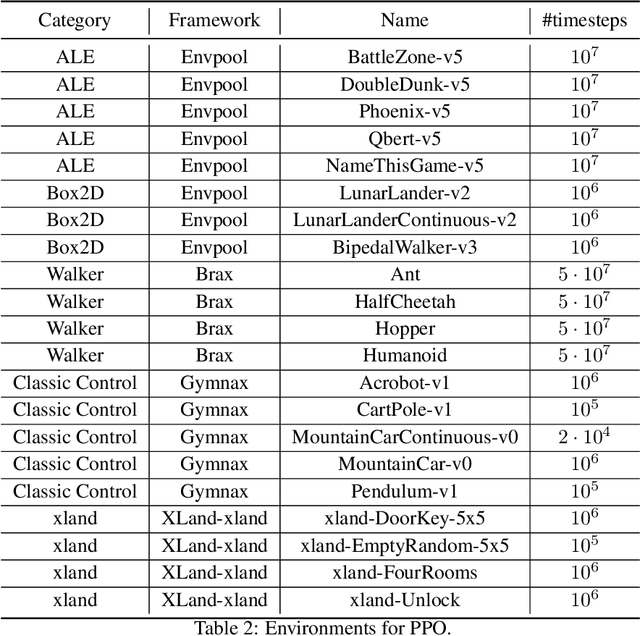
Abstract:Hyperparameters are a critical factor in reliably training well-performing reinforcement learning (RL) agents. Unfortunately, developing and evaluating automated approaches for tuning such hyperparameters is both costly and time-consuming. As a result, such approaches are often only evaluated on a single domain or algorithm, making comparisons difficult and limiting insights into their generalizability. We propose ARLBench, a benchmark for hyperparameter optimization (HPO) in RL that allows comparisons of diverse HPO approaches while being highly efficient in evaluation. To enable research into HPO in RL, even in settings with low compute resources, we select a representative subset of HPO tasks spanning a variety of algorithm and environment combinations. This selection allows for generating a performance profile of an automated RL (AutoRL) method using only a fraction of the compute previously necessary, enabling a broader range of researchers to work on HPO in RL. With the extensive and large-scale dataset on hyperparameter landscapes that our selection is based on, ARLBench is an efficient, flexible, and future-oriented foundation for research on AutoRL. Both the benchmark and the dataset are available at https://github.com/automl/arlbench.
* Accepted at the 17th European Workshop on Reinforcement Learning
Instance Selection for Dynamic Algorithm Configuration with Reinforcement Learning: Improving Generalization
Jul 18, 2024Abstract:Dynamic Algorithm Configuration (DAC) addresses the challenge of dynamically setting hyperparameters of an algorithm for a diverse set of instances rather than focusing solely on individual tasks. Agents trained with Deep Reinforcement Learning (RL) offer a pathway to solve such settings. However, the limited generalization performance of these agents has significantly hindered the application in DAC. Our hypothesis is that a potential bias in the training instances limits generalization capabilities. We take a step towards mitigating this by selecting a representative subset of training instances to overcome overrepresentation and then retraining the agent on this subset to improve its generalization performance. For constructing the meta-features for the subset selection, we particularly account for the dynamic nature of the RL agent by computing time series features on trajectories of actions and rewards generated by the agent's interaction with the environment. Through empirical evaluations on the Sigmoid and CMA-ES benchmarks from the standard benchmark library for DAC, called DACBench, we discuss the potentials of our selection technique compared to training on the entire instance set. Our results highlight the efficacy of instance selection in refining DAC policies for diverse instance spaces.
Structure in Reinforcement Learning: A Survey and Open Problems
Jun 28, 2023Abstract:Reinforcement Learning (RL), bolstered by the expressive capabilities of Deep Neural Networks (DNNs) for function approximation, has demonstrated considerable success in numerous applications. However, its practicality in addressing a wide range of real-world scenarios, characterized by diverse and unpredictable dynamics, noisy signals, and large state and action spaces, remains limited. This limitation stems from issues such as poor data efficiency, limited generalization capabilities, a lack of safety guarantees, and the absence of interpretability, among other factors. To overcome these challenges and improve performance across these crucial metrics, one promising avenue is to incorporate additional structural information about the problem into the RL learning process. Various sub-fields of RL have proposed methods for incorporating such inductive biases. We amalgamate these diverse methodologies under a unified framework, shedding light on the role of structure in the learning problem, and classify these methods into distinct patterns of incorporating structure. By leveraging this comprehensive framework, we provide valuable insights into the challenges associated with structured RL and lay the groundwork for a design pattern perspective on RL research. This novel perspective paves the way for future advancements and aids in the development of more effective and efficient RL algorithms that can potentially handle real-world scenarios better.
AutoML in the Age of Large Language Models: Current Challenges, Future Opportunities and Risks
Jun 13, 2023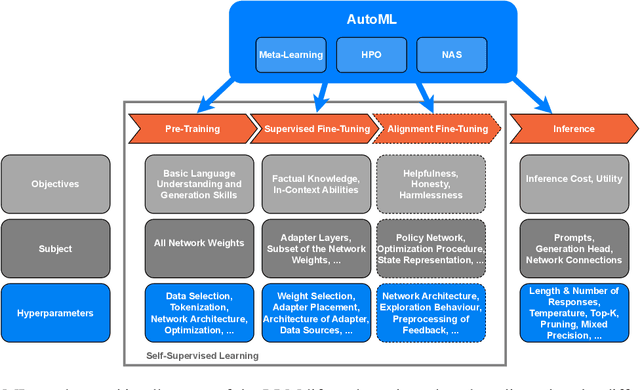

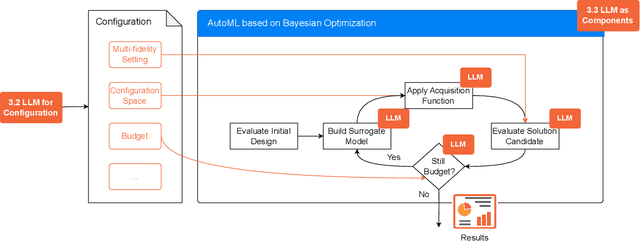
Abstract:The fields of both Natural Language Processing (NLP) and Automated Machine Learning (AutoML) have achieved remarkable results over the past years. In NLP, especially Large Language Models (LLMs) have experienced a rapid series of breakthroughs very recently. We envision that the two fields can radically push the boundaries of each other through tight integration. To showcase this vision, we explore the potential of a symbiotic relationship between AutoML and LLMs, shedding light on how they can benefit each other. In particular, we investigate both the opportunities to enhance AutoML approaches with LLMs from different perspectives and the challenges of leveraging AutoML to further improve LLMs. To this end, we survey existing work, and we critically assess risks. We strongly believe that the integration of the two fields has the potential to disrupt both fields, NLP and AutoML. By highlighting conceivable synergies, but also risks, we aim to foster further exploration at the intersection of AutoML and LLMs.
Learning Activation Functions for Sparse Neural Networks
May 18, 2023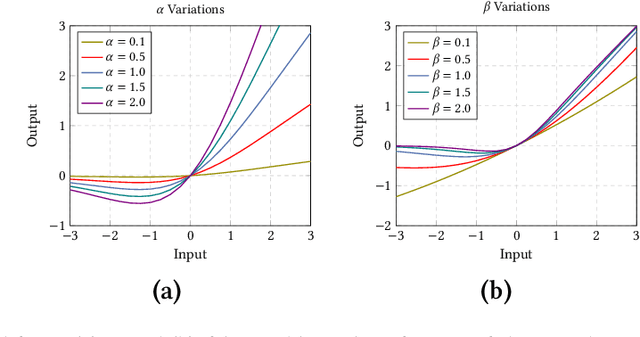



Abstract:Sparse Neural Networks (SNNs) can potentially demonstrate similar performance to their dense counterparts while saving significant energy and memory at inference. However, the accuracy drop incurred by SNNs, especially at high pruning ratios, can be an issue in critical deployment conditions. While recent works mitigate this issue through sophisticated pruning techniques, we shift our focus to an overlooked factor: hyperparameters and activation functions. Our analyses have shown that the accuracy drop can additionally be attributed to (i) Using ReLU as the default choice for activation functions unanimously, and (ii) Fine-tuning SNNs with the same hyperparameters as dense counterparts. Thus, we focus on learning a novel way to tune activation functions for sparse networks and combining these with a separate hyperparameter optimization (HPO) regime for sparse networks. By conducting experiments on popular DNN models (LeNet-5, VGG-16, ResNet-18, and EfficientNet-B0) trained on MNIST, CIFAR-10, and ImageNet-16 datasets, we show that the novel combination of these two approaches, dubbed Sparse Activation Function Search, short: SAFS, results in up to 15.53%, 8.88%, and 6.33% absolute improvement in the accuracy for LeNet-5, VGG-16, and ResNet-18 over the default training protocols, especially at high pruning ratios. Our code can be found at https://github.com/automl/SAFS
AutoRL Hyperparameter Landscapes
Apr 11, 2023Abstract:Although Reinforcement Learning (RL) has shown to be capable of producing impressive results, its use is limited by the impact of its hyperparameters on performance. This often makes it difficult to achieve good results in practice. Automated RL (AutoRL) addresses this difficulty, yet little is known about the dynamics of the hyperparameter landscapes that hyperparameter optimization (HPO) methods traverse in search of optimal configurations. In view of existing AutoRL approaches dynamically adjusting hyperparameter configurations, we propose an approach to build and analyze these hyperparameter landscapes not just for one point in time but at multiple points in time throughout training. Addressing an important open question on the legitimacy of such dynamic AutoRL approaches, we provide thorough empirical evidence that the hyperparameter landscapes strongly vary over time across representative algorithms from RL literature (DQN and SAC) in different kinds of environments (Cartpole and Hopper). This supports the theory that hyperparameters should be dynamically adjusted during training and shows the potential for more insights on AutoRL problems that can be gained through landscape analyses.
Towards Meta-learned Algorithm Selection using Implicit Fidelity Information
Jun 07, 2022



Abstract:Automatically selecting the best performing algorithm for a given dataset or ranking multiple of them by their expected performance supports users in developing new machine learning applications. Most approaches for this problem rely on dataset meta-features and landmarking performances to capture the salient topology of the datasets and those topologies that the algorithms attend to. Landmarking usually exploits cheap algorithms not necessarily in the pool of candidate algorithms to get inexpensive approximations of the topology. While somewhat indicative, handcrafted dataset meta-features and landmarks are likely insufficient descriptors, strongly depending on the alignment of the geometries the landmarks and candidates search for. We propose IMFAS, a method to exploit multi-fidelity landmarking information directly from the candidate algorithms in the form of non-parametrically non-myopic meta-learned learning curves via LSTM networks in a few-shot setting during testing. Using this mechanism, IMFAS jointly learns the topology of of the datasets and the inductive biases of algorithms without expensively training them to convergence. IMFAS produces informative landmarks, easily enriched by arbitrary meta-features at a low computational cost, capable of producing the desired ranking using cheaper fidelities. We additionally show that it is able to beat Successive Halving with at most half the fidelity sequence during test time
Contextualize Me -- The Case for Context in Reinforcement Learning
Feb 09, 2022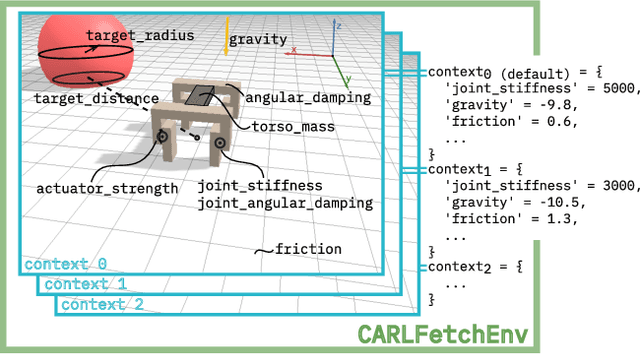
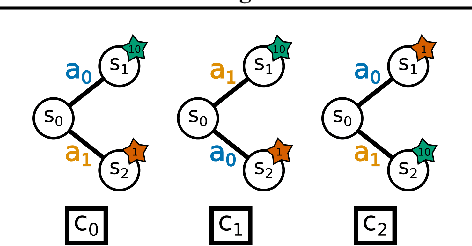
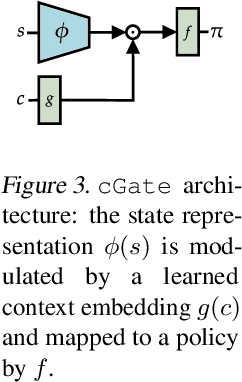
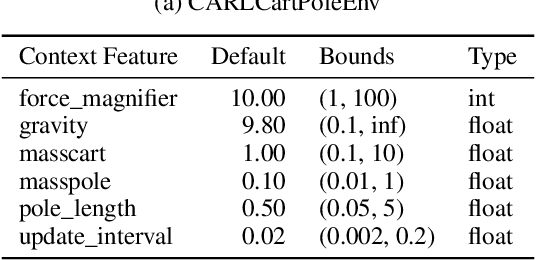
Abstract:While Reinforcement Learning (RL) has made great strides towards solving increasingly complicated problems, many algorithms are still brittle to even slight changes in environments. Contextual Reinforcement Learning (cRL) provides a theoretical framework to model such changes in a principled manner, thereby enabling flexible, precise and interpretable task specification and generation. Thus, cRL is an important formalization for studying generalization in RL. In this work, we reason about solving cRL in theory and practice. We show that theoretically optimal behavior in contextual Markov Decision Processes requires explicit context information. In addition, we empirically explore context-based task generation, utilizing context information in training and propose cGate, our state-modulating policy architecture. To this end, we introduce the first benchmark library designed for generalization based on cRL extensions of popular benchmarks, CARL. In short: Context matters!
 Add to Chrome
Add to Chrome Add to Firefox
Add to Firefox Add to Edge
Add to Edge